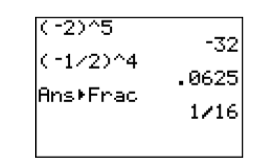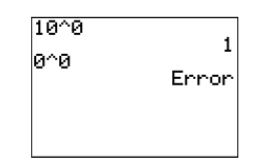2.5: Properties of Exponents
- Page ID
- 92360
In the exponential expression \(a^n\), the number \(a\) is called the base, while the number \(n\) is called the exponent.
Let \(a\) be any real number and let \(n\) be any whole number. If \(n \neq 0\), then:
\[a^{n}=\underbrace{a \cdot a \cdot a \cdots \cdot a}_{n \text { times }} \nonumber \]
That is, to calculate \(a^n\), write \(a\) as a factor \(n\) times. In the case where \(a \neq 0\), but \(n = 0\), then we define:
\[a^0 =1 \nonumber \]
For example, raising a number to the fifth power requires that we repeat the number as a factor five times (see Figure \(\PageIndex{1}\)).
\[\begin{aligned}(-2)^{5} &=(-2)(-2)(-2)(-2)(-2) \\[4pt] &=-32 \end{aligned} \nonumber \]

Raising a number to the fourth power requires that we repeat that number as a factor four times.
\[\begin{aligned}\left(-\dfrac{1}{2}\right)^{4} &=\left(-\dfrac{1}{2}\right)\left(-\dfrac{1}{2}\right)\left(-\dfrac{1}{2}\right)\left(-\dfrac{1}{2}\right) \\ &=\dfrac{1}{16} \end{aligned} \nonumber \]
Remember that if there is a negative in front of the term without parentheses that the negative is not raised to the power.
\[\begin{aligned}-2^4 &=-1 \cdot 2^4 \\&= -1 \cdot (2)(2)(2)(2) \\&= -16 \end{aligned} \nonumber \]
As a final example, note that \(10^0 = 1\), but \(0^0\) is undefined (see Figure \(\PageIndex{2}\)).

For those who may be wondering why \(a^0 = 1\), provided \(a \neq 0\), here is a nice argument. First, note that \(a^1 = a\), so:
\[a \cdot a^{0}=a^{1} \cdot a^{0} \nonumber \]
On the right, repeat the base and add the exponents.
\[a \cdot a^{0}=a^{1} \nonumber \]
Or equivalently:
\[a \cdot a^{0}=a \nonumber \]
Now, divide both sides by \(a\), which is permissible if \(a \neq 0\).
\[\dfrac{a \cdot a^{0}}{a}=\dfrac{a}{a} \nonumber \]
Simplify both sides:
\[a^0 =1 \nonumber \]
Multiplying With Like Bases
In the expression \(a^n\), the number \(a\) is called the base and the number \(n\) is called the exponent. Frequently, we’ll be required to multiply two exponential expressions with like bases, such as \(x^{3} \cdot x^{4}\). Recall that the exponent tells us how many times to write each base as a factor, so we can write:
\[\begin{aligned} x^{3} \cdot x^{4} &=(x \cdot x \cdot x) \cdot(x \cdot x \cdot x \cdot x) \\ &=x \cdot x \cdot x \cdot x \cdot x \cdot x \cdot x \\ &=x^{7} \end{aligned} \nonumber \]
Note that we are simply counting the number of times that \(x\) occurs as a factor. First, we have three \(x’s\), then four \(x’s\), for a total of seven \(x’s\). However a little thought tells us that it is much quicker to simply add the exponents to reveal the total number of times \(x\) occurs as a factor.
\[\begin{aligned} x^{3} \cdot x^{4} &=x^{3+4} \\ &=x^{7} \end{aligned} \nonumber \]
The preceding discussion is an example of the following general property of exponents.
To multiply two exponential expressions with like bases, repeat the base and add the exponents.
\[a^{m} \cdot a^{n}=a^{m+n} \nonumber \]
Simplify each of the following expressions:
- \(y^{4} \cdot y^{8}\)
- \(2^{3} \cdot 2^{5}\)
- \((x+y)^{2}(x+y)^{7}\)
Solution
In each example we have like bases. Thus, the approach will be the same for each example: repeat the base and add the exponents.
\(\begin{aligned} y^{4} \cdot y^{8} &=y^{4+8} \\ &=y^{12} \end{aligned}\)
\(\begin{aligned} 2^{3} \cdot 2^{5} &=2^{3+5} \\ &=2^{8} \\&=256\end{aligned}\)
\(\begin{aligned}(x+y)^{2}(x+y)^{7} &=(x+y)^{2+7} \\ &=(x+y)^{9} \end{aligned}\)
With a little practice, each of the examples can be simplified mentally. Repeat the base and add the exponents in your head: \(y^{4} \cdot y^{8}=y^{12}, 2^{3} \cdot 2^{5}=2^{8}\) and \((x+y)^{2}(x+y)^{7}=(x+y)^{9}\).
\(3^{4} \cdot 3^{2}\)
- Answer
-
\(729\)
Simplify: \(\left(a^{6} b^{4}\right)\left(a^{3} b^{2}\right)\)
Solution
We’ll use the commutative and associative properties to change the order of operation, then repeat the common bases and add the exponents.
\[\begin{aligned} \left(a^{6} b^{4}\right)\left(a^{3} b^{2}\right) &= a^{6} b^{4} a^{3} b^{2} \quad \color {Red} \text { The associative property allows us to regroup in the order we prefer. } \\ &= a^{6} a^{3} b^{4} b^{2} \quad \color {Red} \text { The commutative property allows us to change the order of multiplication. } \\ &= a^{9} b^{6} \quad \color {Red} \text { Repeat the common bases and add the exponents. } \end{aligned} \nonumber \]
With practice, we realize that if all of the operators are multiplication, then we can multiply in the order we prefer, repeating the common bases and adding the exponents mentally: \(\left(a^{6} b^{4}\right)\left(a^{3} b^{2}\right)=a^{9} b^{6}\).
\(\left(x^{2} y^{6}\right)\left(x^{4} y^{3}\right)\)
- Answer
-
\(x^{6} y^{9}\)
Simplify: \(x^{n+3} \cdot x^{3-2 n}\)
Solution
Again, we repeat the base and add the exponents.
\[\begin{aligned} x^{n+3} \cdot x^{3-2 n} &= x^{(n+3)+(3-2 n)} \quad \color {Red}\text { Repeat the base, add the exponents. } \\ &= x^{6-n} \quad \color {Red} \text { Simplify. Combine like terms. } \end{aligned} \nonumber \]
\(x^{5-n} \cdot x^{4 n+2}\)
- Answer
-
\(x^{3 n+7}\)
Dividing With Like Bases
Like multiplication, we will also be frequently asked to divide exponential expressions with like bases, such as \(x^7/x^4\). Again, the key is to remember that the exponent tells us how many times to write the base as a factor, so we can write:
\[\begin{aligned} \dfrac{x^{7}}{x^{4}} &= \dfrac{x \cdot x \cdot x \cdot x \cdot x \cdot x \cdot x}{x \cdot x \cdot x \cdot x} \\ &= \dfrac{\not {x} \cdot \not {x} \cdot \not{x} \cdot \not {x} \cdot x \cdot x \cdot x}{\not {x} \cdot \not {x} \cdot \not {x} \cdot \not {x}} \\ &= x^3 \end{aligned} \nonumber\]
Note how we cancel four \(x’s\) in the numerator for four \(x’s\) in the denominator. However, in a sense we are “subtracting four \(x’s\)” from the numerator, so a faster way to proceed is to repeat the base and subtract the exponents, as follows:
\[\begin{aligned} \dfrac{x^{7}}{x^{4}} &=x^{7-4} \\ &=x^{3} \end{aligned} \nonumber \]
The preceding discussion is an example of the second general property of exponents.
To divide two exponential expressions with like bases, repeat the base and subtract the exponents. Given \(a \neq 0\),
\[\dfrac{a^{m}}{a^{n}}=a^{m-n} \nonumber \]
Note that the subtraction of the exponents follows the rule “top minus bottom.”
Simplify each of the following expressions:
- \(\frac{x^{12}}{x^{3}}\)
- \(\frac{5^{7}}{5^{7}}\)
- \(\frac{(2 x+1)^{8}}{(2 x+1)^{3}}\)
Solution
In each example we have like bases. Thus, the approach will be the same for each example: repeat the base and subtract the exponents.
\(\begin{aligned} \dfrac{x^{12}}{x^{3}} &=x^{12-3} \\ &=x^{9} \end{aligned}\)
\(\begin{aligned} \dfrac{5^{7}}{5^{7}} &=5^{7-7} \\ &=5^{0} \\ &=1 \end{aligned}\)
\(\begin{aligned} \dfrac{(2 x+1)^{8}}{(2 x+1)^{3}} &=(2 x+1)^{8-3} \\ &=(2 x+1)^{5} \end{aligned}\)
With a little practice, each of the examples can be simplified mentally. Repeat the base and subtract the exponents in your head: \(x^{12} / x^{3}=x^{9}, 5^{7} / 5^{4}=5^{3}\) and \((2 x+1)^{8} /(2 x+1)^{3}=(2 x+1)^{5}\).
\(\dfrac{4^{5}}{4^{3}}\)
- Answer
-
\(16\)
Simplify: \(\dfrac{12 x^{5} y^{7}}{4 x^{3} y^{2}}\)
Solution
We first express the fraction as a product of three fractions, the latter two with a common base. In the first line of the following solution, note that if you multiply numerators and denominators of the three separate fractions, the product equals the original fraction on the left.
\[\begin{aligned} \dfrac{12 x^{5} y^{7}}{4 x^{3} y^{2}} &= \dfrac{12}{4} \cdot \dfrac{x^{5}}{x^{3}} \cdot \dfrac{y^{7}}{y^{2}} \quad \color {Red} \text { Break into a product of three fractions. } \\ &= 3 x^{5-3} y^{7-2} \quad \color {Red} \text { Simplify: } 12 / 4=3 . \text { Then repeat the common } \\ &= 3 x^{2} y^{5} \quad \color {Red} \text { Simplify. } \end{aligned} \nonumber \]
Simplify: \(\dfrac{15 a^{6} b^{9}}{3 a b^{5}}\)
- Answer
-
\(5 a^{5} b^{4}\)
Simplify: \(\dfrac{x^{5 n-4}}{x^{3-2 n}}\)
Solution
Again, we repeat the base and subtract the exponents.
\[\begin{aligned} \dfrac{x^{5 n-4}}{x^{3-2 n}} &= x^{(5 n-4)-(3-2 n)} \quad \color {Red} \text { Repeat the base, subtract exponents. } \\ &= x^{5 n-4-3+2 n} \quad \color {Red} \text { Distribute the minus sign. } \\ &= x^{7 n-7} \quad \color {Red} \text { Simplify. Combine like terms. } \end{aligned} \nonumber \]
Simplify: \(\dfrac{x^{3 n-6}}{x^{n+2}}\)
- Answer
-
\(x^{2 n-8}\)
Raising a Power to a Power
Suppose we have an exponential expression raised to a second power, such as \((x^2)^3\). The second exponent tells us to write \(x^2\) as a factor three times:
\[\begin{aligned} \left(x^{2}\right)^{3} &= x^{2} \cdot x^{2} \cdot x^{2} \quad \color {Red} \text { Write } x^{2} \text { as a factor three times. } \\ &= x^{6} \quad \color {Red} \text { Repeat the base, add the exponents. } \end{aligned} \nonumber \]
Note how we added \(2 + 2 + 2\) to get \(6\). However, a much faster way to add “three twos” is to multiply: \(3 \cdot 2=6\). Thus, when raising a “power to a second power,” repeat the base and multiply the exponents, as follows:
\[\begin{aligned}\left(x^{2}\right)^{3} &=x^{2 \cdot 3} \\ &=x^{6} \end{aligned} \nonumber \]
The preceding discussion gives rise to the following third property of exponents.
When raising a power to a power, repeat the base and multiply the exponents. In symbols:
\[(a^m)^n = a^{mn} \nonumber \]
Note that juxtaposing two variables, as in \(mn\), means “\(m\) times \(n\).”
Simplify each of the following expressions:
- \(\left(z^{3}\right)^{5}\)
- \(\left(7^{3}\right)^{0}\)
- \(\left[(x-y)^{3}\right]^{6}\)
Solution
In each example we are raising a power to a power. Hence, in each case, we repeat the base and multiply the exponents.
\(\begin{aligned}\left(z^{3}\right)^{5} &=z^{3.5} \\ &=z^{15} \end{aligned}\)
\(\begin{aligned}\left(7^{3}\right)^{0} &=7^{3.0} \\ &=7^{0} \\ &=1 \end{aligned}\)
\(\begin{aligned}\left[(x-y)^{3}\right]^{6} &=(x-y)^{3 \cdot 6} \\ &=(x-y)^{18} \end{aligned}\)
With a little practice, each of the examples can be simplified mentally. Repeat the base and multiply the exponents in your head: \(\left(z^{3}\right)^{5}=z^{15},\left(7^{3}\right)^{4}=7^{12}\) and \(\left[(x-y)^{3}\right]^{6}=(x-y)^{18}\).
Simplify: \(\left(2^{3}\right)^{4}\)
- Answer
-
\(4096\)
Simplify: \(\left(x^{2 n-3}\right)^{4}\)
Solution
Again, we repeat the base and multiply the exponents.
\[\begin{aligned} \left(x^{2 n-3}\right)^{4} &= x^{4(2 n-3)} \quad \color {Red} \text { Repeat the base, multiply exponents. } \\ &= x^{8 n-12} \quad \color {Red} \text { Distribute the } 4 . \end{aligned} \nonumber \]
Simplify: \(\left(a^{2-n}\right)^{3}\)
- Answer
-
\(a^{6-3 n}\)
Raising a Product to a Power
We frequently have need to raise a product to a power, such as \((xy)^3\). Again, remember the exponent is telling us to write \(xy\) as a factor three times, so:
\[\begin{aligned} (x y)^{3} &=(x y)(x y)(x y) \quad \color {Red} \text {Write } xy \text { as a factor three times.}\\ &=x y x y x y \quad \color {Red} \text {The associative property allows us to group as we please.}\\ &=x x x y y y \quad \color {Red} \text {The commutative property allows us to change the order as we please.}\\ &=x^{3} y^{3} \quad \color {Red} \text {Invoke the exponent definition: } x x x=x^{3} \text { and } y y y=y^{3} \end{aligned} \nonumber \]
However, it is much simpler to note that when you raise a product to a power, you raise each factor to that power. In symbols: \[(xy)^3 = x^3y^3 \nonumber \]
The preceding discussion leads us to a fourth property of exponents.
To raise a product to a power, raise each factor to that power. In symbols:
\[(ab)^n = a^nb^n \nonumber \]
Simplify each of the following expressions:
- \((y z)^{5}\)
- \((-3 y)^{2}\)
Solution
In each example we are raising a product to a power. Hence, in each case, we raise each factor to that power.
\((y z)^{5}=y^{5} z^{5}\)
\(\begin{aligned}(-3 y)^{2} &=(-3)^{2} y^{2} \\ &=9 y^{2} \end{aligned}\)
With a little practice, each of the examples can be simplified mentally. Raise each factor to the indicated power in your head: \((y z)^{5}=y^{5} z^{5} and \((-3 y)^{2}=9 y^{2}\)
Simplify: \((-2 b)^{4}\)
- Answer
-
\(16 b^{4}\)
When raising a product of three factors to a power, it is easy to show that we should raise each factor to the indicated power. For example, \((a b c)^{3}=a^{3} b^{3} c^{3}\). In general, this is true regardless of the number of factors. When raising a product to a power, raise each of the factors to the indicated power.
Simplify: \(\left(-2 a^{3} b^{2}\right)^{3}\)
Solution
Raise each factor to the third power, then simplify.
\[\begin{aligned} \left(-2 a^{3} b^{2}\right)^{3} &= (-2)^{3}\left(a^{3}\right)^{3}\left(b^{2}\right)^{3} \quad \color {Red} \text { Raise each factor to the third power. } \\ &= -8 a^{9} b^{6} \quad \color {Red} \text {Simplify: } (-2)^{3}=-8 \text {. In the remaining factors, raising a power to a power requires that we multiply the exponents. } \end{aligned} \nonumber \]
Simplify: \(\left(-3 x y^{4}\right)^{5}\)
- Answer
-
\(-243 x^{5} y^{20}\)
Simplify: \(\left(-2 x^{2} y\right)^{2}\left(-3 x^{3} y\right)\)
Solution
In the first grouped product, raise each factor to the second power.
\[\begin{aligned} \left(-2 x^{2} y\right)^{2}\left(-3 x^{3} y\right) &=\left((-2)^{2}\left(x^{2}\right)^{2} y^{2}\right)\left(-3 x^{3} y\right) \quad \color {Red} \text { Raise each factor in the first grouped product to the second power.} \\ &=\left(4 x^{4} y^{2}\right)\left(-3 x^{3} y\right) \quad \color {Red} \text { Simplify: } (-2)^{2}=4 \text { and } \left(x^{2}\right)^{2}=x^{4} \end{aligned} \nonumber \]
The associative and commutative property allows us to multiply all six factors in the order that we please. Hence, we’ll multiply \(4\) and \(−3\), then \(x^4\) and \(x^3\), and \(y^2 and y, in that order. In this case, we repeat the base and add the exponents.
\[\begin{aligned} &=-12x^7y^3 \quad \color {Red} \text { Simplify: } (4)(-3)=-12. \text { Also, } x^{4}x^3=x^{7} \text { and } y^2y = y^3\end{aligned} \nonumber\]
Simplify: \(\left(a^{3} b^{2}\right)^{3}\left(-2 a^{2} b^{4}\right)^{2}\)
- Answer
-
\(4 a^{13} b^{14}\)
Raising a Quotient to a Power
Raising a quotient to a power is similar to raising a product to a power. For example, raising \((x/y)^3\) requires that we write \(x/y\) as a factor three times.
\[\begin{aligned}\left(\frac{x}{y}\right)^{3} &=\frac{x}{y} \cdot \frac{x}{y} \cdot \frac{x}{y} \\ &=\frac{x \cdot x \cdot x}{y \cdot y \cdot y} \\ &=\frac{x^{3}}{y^{3}} \end{aligned} \nonumber \]
However, it is much simpler to realize that when you raise a quotient to a power, you raise both numerator and denominator to that power. In symbols:
\[\left(\dfrac{x}{y}\right)^{3}=\frac{x^{3}}{y^{3}} \nonumber \]
This leads to the fifth and final property of exponents.
To raise a quotient to a power, raise both numerator and denominator to that power. Given \(b \neq 0\),
\[\left(\dfrac{a}{b}\right)^{n}=\dfrac{a^{n}}{b^{n}} \nonumber \]
Simplify each of the following expressions:
- \(\left(\dfrac{2}{3}\right)^{2}\)
- \(\left(\dfrac{x}{3}\right)^{3}\)
- \(\left(-\dfrac{2}{y}\right)^{4}\)
Solution
In each example we are raising a quotient to a power. Hence, in each case, we raise both numerator and denominator to that power.
\(\begin{aligned}\left(\dfrac{2}{3}\right)^{2} &=\dfrac{2^{2}}{3^{2}} \\ &=\dfrac{4}{9} \end{aligned}\)
\(\begin{aligned}\left(\dfrac{x}{3}\right)^{3} &=\dfrac{x^{3}}{3^{3}} \\ &=\dfrac{x^{3}}{27} \end{aligned}\)
\(\begin{aligned}\left(-\dfrac{2}{y}\right)^{4} &=\dfrac{2^{4}}{y^{4}} \\ &=\dfrac{16}{y^{4}} \end{aligned}\)
Note that in example (3), raising a negative base to an even power produces a positive result. With a little practice, each of the examples can be simplified mentally. Raise numerator and denominator to the indicated power in your head: \((2 / 3)^{2}=4 / 9,(x / 3)^{3}=x^{3} / 27,\) and \((-2 / y)^{4}=16 / y^{4}\)
Simplify: \(\left(\dfrac{5}{4}\right)^{3}\)
- Answer
-
\(\dfrac{125}{64}\)
Simplify: \(\left(\dfrac{2 x^{5}}{y^{3}}\right)^{2}\)
Solution
Raise both numerator and denominator to the second power, then simplify:
\[\begin{aligned} \left(\dfrac{2 x^{5}}{y^{3}}\right)^{2}=\dfrac{\left(2 x^{5}\right)^{2}}{\left(y^{3}\right)^{2}} \quad \color {Red} \text {Raise numerator and denominator to the second power.} \end{aligned} \nonumber\]
In the numerator, we need to raise each factor of the product to the second power. Then we need to remind ourselves that when we raise a power to a power, we multiply the exponents.
\[\begin{aligned} &= \dfrac{2^{2}\left(x^{5}\right)^{2}}{\left(y^{3}\right)^{2}} \quad \color {Red} \text {Raise each factor in the numerator and denominator to the second power.} \\ &= \dfrac{4 x^{10}}{y^{6}} \quad \color {Red} \text { Simplify: } 2^{2}=4,\left(x^{5}\right)^{2}=x^{10} \text {, and } (y^3)^2=y^6 \end{aligned} \nonumber\]
Simplify: \(\left(\dfrac{a^{4}}{3 b^{2}}\right)^{3}\)
- Answer
-
\(\dfrac{a^{12}}{27 b^{6}}\)


